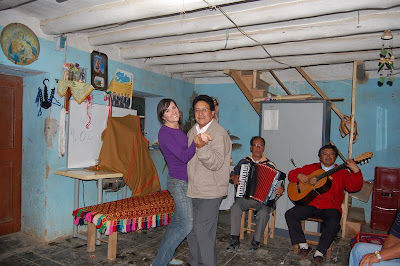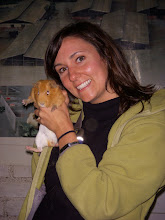They also like to think of themselves as their own separate country, joking that passports are required to enter their “independent republic.” Kind of like Texas, if you will, which is one more reason to love it. Another reason: Arequipa is renowned for their delicious food. From ceviche to rocoto relleno (a wonderfully spicy pepper stuffed with beef and cheese) to queso helado (literally translates to frozen cheese, which sounds gross but is oh-so-good), Arequipa is sure to burst your buttons. What better place to celebrate Thanksgiving, no?
This trip was scheduled over a year ago, upon learning that two volunteers would be placed there with a family that runs a buffet restaurant… I’ve been drooling in anticipation ever since.
The city of Arequipa, second largest in Peru, is stunningly beautiful, with mountainous views, cobble-stone streets and gleaming white buildings (it is nicknamed “The White City,” as most of its buildings are constructed from a white volcanic rock called sillar).
While I was chiefly concerned with what, exactly, I would eat in Arequipa, I completely forgot to do any research on what else there is to see and do there. Fortunately for us, our volunteer friend John met us in the city and gave us the grand tour. John just happens to be an aspiring Chef, so our tour was actually 78% food-related, which was a-ok me.

Just a couple of "yankees" down from the north

Plaza de Armas at dusk
Between stuffing ourselves silly every two to three hours, we managed to see the sights, including a tour of the beautifully medieval Monastery, dating back to the 1500’s. One of the highlights of the tour was our trip to the local market, which I always love in Peru. There is so much bustling about, as locals buy and sell their produce, meats, spices and just about anything else you could require. Plus, there’s always that one unique feature that identifies a city within its market stalls. In Iquitos, it was the witch-craft loot. In Arequipa, the frog milkshake stand fills that role. Said to relieve stress, the shake consists of a whole frog, skinned, sautéed (but not gutted or de-boned) and puréed with a milk-like substance.
In the end, it’s not a bad little snack, except that it’s hot, slightly lumpy and everyone is aware of the fact that it’s made from frog guts. In addition, your appetite is somewhat curbed by watching them kill the live frogs right in front of you. This involves pulling one unlucky fellow from an aquarium, banging him against a table a few times, then in a rapid flurry of movements, the skin is peeled off in one foul swoop. After that, it’s into the frying pan for you, my little friend! As for the stress-relief, I’m not so sure about that, unless you really despise frogs and wish them ill will.


The lovely Monastery
More fun things for sale in the Market: Alpaca!
The "frog juice" stand
A cute fake frog amongst the real ones...to lighten up the mood, I suppose?

If you look closely, you'll see the froggy in his right hand, literally on his last legs. HaHa.
On Thanksgiving morning, we made our way to Chivay, where a group of 18 people were waiting in the restaurant to begin cooking. The owners of the restaurant, Enrique and Amanda, were so excited about our presence there that they gave us complete access to the kitchen and all of its equipment, even pulling out chef’s uniforms for all of us to don. Dividing responsibilities, we made the most perfect Thanksgiving spread, with turkey, stuffing, gravy, cranberry, mashed potatoes, biscuits and more. Take a dozen or so semi-starved Peace Corps volunteers and throw them into an opportunity like this, and you’re sure to have some serious over-indulgence on your hands, almost bordering on the obscene. Most of us were forced to adopt the gross-Peruvian-man technique of lifting up the shirt and appreciatively rubbing the belly.
On the ride to Chivay, we passed over this spot, which is over 16,000 feet above sea level. It's what I imagine Mars to look like.
Tasted even better than it looks!
In order to feel slightly better about our gluttonous behavior the day before, we spent most of Friday on a “bike and hike” excursion (only after starting the morning off with espresso and left-over pie). Chivay just happens to be at the base of the Colca Canyon, which is the deepest in the world. In your face Grand Canyon! We spent the next few days touring different Peace Corps sites around the canyon, taking in the sights and even accidentally stumbling upon a giant condor up close, which are famous in the area (some tourists come just for this, and spend hours or sometimes days looking for them). Then it was back to the city for a last 24-hour session of stuffing our faces… or fatting up for the winter, as I like to think of it.

Sharing the roads with local ladies and local llamas
Colca Canyon
Most homes here are built out of stone, and blend in perfectly with the lanscape
Typical dress of Arequipa
Our bike ride took us to some pre-Incan tombs... creepy
Bones everywhere
According to local custom, I left my offering
Kristen's site, Cabanaconde, is the starting point for most hikes into the Canyon
Our accidental condor sighting
This trip just reminded me why Thanksgiving is my personal favorite. It is the underdog of holidays, Christmas’s red-headed stepchild. But it is the most genuine of holidays… no gifts, no jingles, just food. And family, of course. Many thanks to Jean, Russ, John, Kristen, Enrique, Amanda and all the others who welcomed us into their Arequipa family.
Now, as we all know, Thanksgiving is all about sharing, so I give to you all the delectable recipe for frog milkshakes (roughly translated into American ingredients), just in case you want to serve them at your next get-together. Provecho!
• 1 large frog, skinned and sautéed over a low flame (see first photo below)
• 1 TBSP honey
• 1 cup of ground cereal
• 2 tsp Bee Pollen
• 1 tsp chocolate syrup
• 2 cups soy milk
• 1 whole, uncracked, quail egg (see second photo below)
Throw all ingredients into a blender, mixing until (somewhat) smooth and creamy. Enjoy with friends!























































